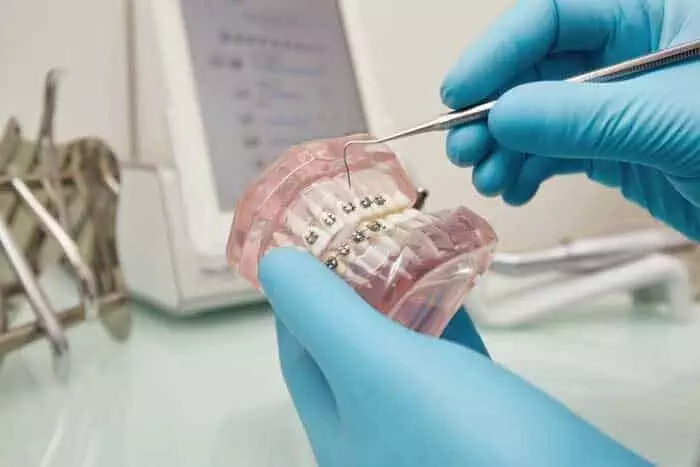Table of Contents
Bracelets are in use for ages and are very effective in correcting various issues referring to teeth position, bite, and alignment.
Technology developed implied the evolution of the bracelets. Today, we have several types of bracelets created to meet the different needs of patients. Dental Implants Harrisburg NC experts are specialists in this dental domain and provided us with a guide on this orthodontic apparatus.

What are fixed braces?
Braces are orthodontic devices used to correct mal-positioned teeth and jaw, misaligned teeth row or bite, straight rotated teeth, malocclusion, the gap between the teeth, overcrowded or overlapping teeth, and other functional and esthetic issues. Depending on the material they are created, braces might be:
- Metal
- Ceramic
- Self-ligating
- Lingual
- Clear aligners
Different types of braces offer different aesthetics, hygiene, cost, and final result. Depending on these factors, the patient and dentist will discuss the most suitable type of braces.
Metal braces
These are traditional types of braces and once, not so long ago, these were the only braces choices for patients. They are made out of stainless steel. Metal braces contain metal brackets attached to the teeth’ surface with a glue bond and an archwire that connects the brackets. An archwire is attached to brackets with an elastic tie. The orthodontist makes adjustments in the pressure and position of brackets to achieve the desired tooth movement. These adjustments are usually made every four to eight weeks.
Metal braces are fixed to teeth and unlike aligners can not be removed without a dentist.
The advantages of metal braces are that they are the most affordable type of braces, very effective and versatile, suitable for children as parents don’t need to remind them to put braces on, and orthodontist appointments are required once every one or two months.
The disadvantages of metal braces are that they require thorough oral hygiene and they are the most noticeable type of braces.
Ceramic braces
Ceramic braces are made of ceramic in the same color as teeth or in clear color which makes them almost invisible. The ceramic part is invisible but connected with an archwire. Compared to metal braces, ceramic brackets are slightly larger. Also, they tend to stain more contrary to metal brackets.
The advantages of ceramic braces are: they are less visible than metal ones provide more aesthetic and are more effective than clear aligners.
The disadvantage of ceramic braces is that they require proficient oral hygiene as they tend to stain more quickly. They are more expensive than traditional braces.
Self-ligating brackets
Self-ligating braces are similar to traditional metal braces. The difference between standard metal braces and self-ligating is that second use doors or clips to keep the wire in its place, contrary to elastic ties used in metal braces. These are also made of stainless steel or ceramic. Because of the self-ligating built-in system mechanisms, they are easier to adjust.
Contrary to elastic ties that are effective only until they lose their elasticity (after which no teeth movement can be achieved and they require replacement), doors, and clips in self-ligating braces provide effective pressure and moving the teeth which makes them more efficient than metal braces.
There are two kinds of self-ligating braces depending on their press mechanism:
Active brackets – sliding slip clips are pressed against the archwire achieving constant activity and moving the teeth
Passive brackets – sliding mechanism doesn`t press archwire and retains teeth without realizing movement.
The advantages of self-ligating braces require a shorter time of session due to their efficiency in adjustment and are very effective.
The major disadvantage of self-ligating braces is in their visibility due to the presence of the wire and doors or clips.
Lingual braces
Lingvinal braces are attached to the inner side of the teeth and inside the mouth. This approach requires special techniques. This is the least frequent in orthodontic practice because it’s only applicable in particular cases and conditions.
The advantage of lingual braces is that they are completely invisible which is a great benefit for people looking for aesthetics.
The disadvantages of this method are few. The major issue with lingual braces is that they are not adequate for just any kind of correction and are restricted to just certain types of cases. They can cause teeth trauma and teeth ulcerations. Also, because they are palace inside of the mouth, they can cause discomfort and changes in speech and tongue irritations.
Clear Aligners also called Invisalign
These types of braces are not fixed orthodontic apparatus contrary to the previously mentioned types. They are effective in correcting most teeth alignment issues but are not an adequate solution for severe problems.
The advantages of clear aligners are that they are invisible offer an aesthetic approach, easy to maintain hygiene, are removable, and require fewer dentist visitations.
The disadvantage of clear aligners is that they are not proficient in severe conditions and their cost is significantly higher than for other braces types.
Summary
Which braces type is most suitable defers from case to case. The orthodontist will comprehend the proportions of the issue and the appropriate braces to achieve the desired results. Some issues can be treated with various kinds of braces and the one that will be applied will depend on patients’ aesthetic requirements and budget. If you’d like to know more about dental implants be sure to check out The Point Dental.


